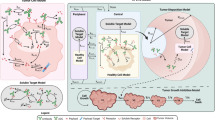Summary
We have developed a pharmacokinetic/pharmacodynamic approach that integrates the disposition, cytotoxic activity and interaction of anticancer drugs. Fundamental to this approach is the measurement of the cytotoxicity, against a “target” cell line, of patient plasma collected at different times after administration of the anticancer agent(s). To illustrate this approach, we have studied the plasma cytotoxic activity (PCA), against HL-60 cells, of plasma from 11 acute myeloblastic leukemic patients treated with daunorubicin (DNR). Plasma, obtained before and serially for 24 h after DNR treatment, was assayed by HPLC for DNR and daunorubicinol (DNRol), its active metabolite. The corresponding observed PCA values (PCAobs) against HL-60 cells were also measured with a flow-cytometric cell-survival assay that we had developed previously. The pharmacodynamics, i.e. PCA, were co-modeled (dual Hill equation with an interaction term to allow synergism or antagonism) with the pharmacokinetics. The intergration of the PCA profile provided the area under the observed PCA versus time curve (AUCobs). For each patient, we also generated an “interaction panel”, by adding known amounts of DNR and DNRol to his or her pretreatment plasma. The corresponding cytotoxicities were measured, and then applied to the pharmacodynamic model. This provided a standard surface from which the PCA of each sample obtained after therapy was predicted (PCAprd), on the basis of assayed concentrations of DNR and DNRol in that sample. For plasma samples obtained after treatment, the model simultaneously fit all three outputs, i.e. PCA and DNR/DNRol concentration, very well. We observed substantial interpatient variability in HL-60 growth rate in medium containing patient pretreatment plasma, in DNR activity in pretreatment plasma, and in the in vitro activity (PCA) of plasma obtained after DNR treatment. We also compared the AUCprd to the AUCobs for each patient, and we identified a subset of 4/11 acute myeloblastic leukemic patients who had developed much more PCA after DNR administration than could be explained by the measured concentrations of DNR and DNRol. This may be due to unidentified active metabolites or to factors produced in the plasma in response to the treatment. This pharmacokinetic/pharmacodynamic model is promising to describe pharmacodynamics and interactions of anticancer drugs in cancer patients.
Similar content being viewed by others
References
Bachur NR, Cradock JC (1970) Daunomycin metabolism in rat tissue slices. J Pharmacol Exp Ther 175: 331
Bachur NR, Gee M (1971) Daunorubicin metabolism by rat tissue preparations. J Pharmacol Exp Ther 177: 567
Bachur NR, Steele M, Meriwether WD, Hildebrand RC (1976) Cellular pharmacodynamics of several anthracycline antibiotics. J Med Chem 19: 651
Benjamin RS, Riggs CE, Bachur NR (1977) Plasma pharmacokinetics of Adriamycin and its metabolites in humans with normal hepatic and renal function. Cancer Res 37: 1416
Chabner BA (1990) Cytidine analogues. In: BA Chabner, JM Collins (eds) Cancer chemotherapy: principles and practice. Lippincott, Philadelphia, pp 154–179
Chou TC, Talalay P (1984) Quantitative analysis of dose-effect relationships: the combined effects of multiple drugs or enzyme inhibitors. Adv Enz Regul 22: 27
D'Argenio DZ, Schumitzky A (1979) A program package for simulation and parameter estimation in pharmacokinetic systems. Comput Programs Biomed 9: 115
Erb N, Erttmann R, Landbeck G (1986) A rapid chromatographic procedure for the determination of adriamycin, daunomycin and their 13-OH metabolites adriamycinol and daunomycinol. Cancer Chemother Pharmacol 17: 53
Evans WE, Crom WR, Stewart CF, Bowman WP, Chen C-H, Abromowitch M, Simone JV (1984) Methotrexate systemic clearance influences probability of relapse in children with standard risk acute lymphocytic leukaemia. Lancet 1: 359
Ho DHW, Frei E (1971) Clinical pharmacology of 1-β-d-arabinofuranosyl cytosine. Clin Pharmacol Ther 12: 944
Huffman DH, Benjamin RS, Bachur NR (1972) Daunorubicin metabolism in acute nonlymphocytic leukemia. Clin Pharmacol Ther 13: 895
Kokenberg E, Sonneveld P, Sizoo W, Hagenbeek A, Löwenberg B (1988) Cellular pharmacokinetics of daunorubicin: relationships with the response to treatment in patients with acute myeloid leukemia. J Clin Oncol 6: 802
Paul C, Liliemark J, Tidefelt U, Gahrton G, Peterson C (1989) Pharmacokinetics of daunorubicin and doxorubicin in plasma and leukemic cells from patients with acute nonlymphoblastic leukemia. Ther Drug Monit 11: 140
Riggs CE (1984) Clinical pharmacology of daunorubicin in patients with acute leukemia. Semin Oncol 11: 2
Ross DD, Akman SA, Schrecker AW, Bachur NR (1981) Effects of deoxynucleosides on cultured human leukemia cell growth and deoxynucleoside pools. Cancer Res 41: 4493
Ross DD, Joneckis CC, Ordóñez JV, Sisk AM, Wu RK, Hamburger AW, Nora RE (1989) Estimation of cell survival by flow cytometric quantification of fluorescein diacetate/propidium iodide viable cell number. Cancer Res 49: 3776
Sheiner LB, Beal SL (1982) Bayesian individualization of pharmacokinetics: Simple implementation and comparison with non-Bayesian methods. J Pharm Sci 71: 1344
Weinstein JH, Griffin TW, Feeney J, Cohen HJ, Propper RD, Sallan SE (1982) Pharmacokinetics of continuous intravenous and subcutaneous infusions of cytosine arabinoside. Blood 59: 1351
Yamaoka K, Nakagawa T, Uno T (1978) Application of Akaike's information criterion (AIC) in the evaluation of linear pharmacokinetic equations. J Pharmacokinet Biopharm 6: 165
Author information
Authors and Affiliations
Rights and permissions
About this article
Cite this article
de Valeriola, D.L., Ross, D.D., Forrest, A. et al. Use of plasma cytotoxic activity to model cytotoxic pharmacodynamics of anticancer drugs. Cancer Chemother. Pharmacol. 29, 133–140 (1991). https://doi.org/10.1007/BF00687323
Received:
Accepted:
Issue Date:
DOI: https://doi.org/10.1007/BF00687323




